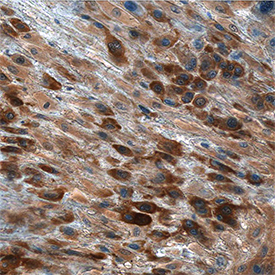Human IGF-I/IGF-1 Antibody Summary
Gly49-Ala118
Accession # P05019
Applications
Please Note: Optimal dilutions should be determined by each laboratory for each application. General Protocols are available in the Technical Information section on our website.
Scientific Data
 View Larger
View Larger
IGF-I/IGF-1 in Human Placenta. IGF-I/IGF-1 was detected in immersion fixed paraffin-embedded sections of human placenta using Goat Anti-Human IGF-I/IGF-1 Recombinant Monoclonal Antibody (Catalog # MAB2911) at 3 µg/mL overnight at 4 °C. Tissue was stained using the Anti-Goat HRP-DAB Cell & Tissue Staining Kit (brown; Catalog # CTS008) and counterstained with hematoxylin (blue). Specific staining was localized to cytoplasm in decidual cells. View our protocol for Chromogenic IHC Staining of Paraffin-embedded Tissue Sections.
Reconstitution Calculator
Preparation and Storage
- 12 months from date of receipt, -20 to -70 °C as supplied.
- 1 month, 2 to 8 °C under sterile conditions after reconstitution.
- 6 months, -20 to -70 °C under sterile conditions after reconstitution.
Background: IGF-I/IGF-1
Insulin-like growth factor I, also known as somatomedin C, is the dominant effector of growth hormone and is structurally homologous to proinsulin. Human IGF-I is synthesized as two precursor isoforms with N- and alternate C-terminal propeptides (1). These isoforms are differentially expressed by various tissues (1). The 7.6 kDa mature IGF-I is identical between isoforms and is generated by proteolytic removal of the N- and C-terminal regions. Mature human IGF‑I shares 94% and 96% aa sequence identity with mouse and rat IGF-I, respectively (2), and exhibits cross-species activity. It shares 64% aa sequence identity with mature human
IGF‑II. Circulating IGF‑I is produced by hepatocytes, while local IGF-I is produced by many other tissues in which it has paracrine effects (1). IGF-I induces the proliferation, migration, and differentiation of a wide variety of cell types during development and postnatally (3). IGF-I regulates glucose and fatty acid metabolism, steroid hormone activity, and cartilage and bone metabolism (4-7). It plays an important role in muscle regeneration and tumor progression (1, 8). IGF-I binds IGF‑I R, IGF-II R, and the insulin receptor, although its effects are mediated primarily by IGF-I R (9). IGF-I association with IGF binding proteins increases its plasma half‑life and modulates its interactions with receptors (10).
- Philippou, A. et al. (2007) In Vivo 21:45.
- Sandberg-Nordqvist, A.C. et al. (1992) Brain Res. Mol. Brain Res. 12:275.
- Guvakova, M.A. (2007) Int. J. Biochem. Cell Biol. 39:890.
- Clemmons, D.R. (2006) Curr. Opin. Pharmacol. 6:620.
- Bluher, S. et al. (2005) Best Pract. Res. Clin. Endocrinol. Metab. 19:577.
- Garcia-Segura, L.M. et al. (2006) Neuroendocrinology 84:275.
- Malemud, C.J. (2007) Clin. Chim. Acta 375:10.
- Samani, A.A. et al. (2007) Endocrine Rev. 28:20.
- LeRoith, D. and S. Yakar (2007) Nat. Clin. Pract. Endocrinol. Metab. 3:302.
- Denley, A. et al. (2005) Cytokine Growth Factor Rev. 16:421.
Product Datasheets
Product Specific Notices
* Contains <0.1% Sodium Azide, which is not hazardous at this concentration according to GHS classifications. Refer to SDS for additional information and handling instructions.FAQs
No product specific FAQs exist for this product, however you may
View all Antibody FAQsReviews for Human IGF-I/IGF-1 Antibody
Average Rating: 5 (Based on 1 Review)
Have you used Human IGF-I/IGF-1 Antibody?
Submit a review and receive an Amazon gift card.
$25/€18/£15/$25CAN/¥75 Yuan/¥2500 Yen for a review with an image
$10/€7/£6/$10 CAD/¥70 Yuan/¥1110 Yen for a review without an image
Filter by:




